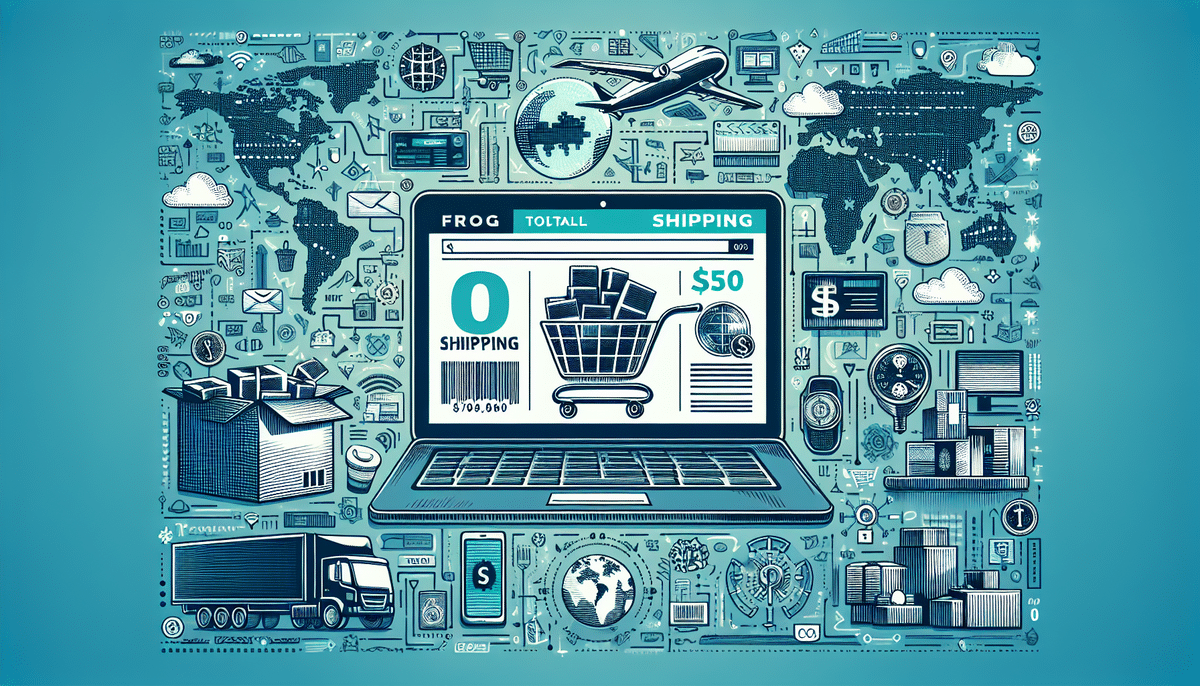7 Profitable Free Shipping Tips to Increase Your Online Sales
If you run an online business, you're likely already well aware of the importance of free shipping. Studies have shown that offering free shipping can significantly increase your online sales by reducing cart abandonment and boosting customer satisfaction. However, deciding on the right free shipping strategy for your business can be a challenge.
Why Free Shipping is Essential for Online Sales
First and foremost, it's important to understand why free shipping is essential for online sales. When customers are browsing online, they're constantly comparing prices across different websites. If your website doesn't offer free shipping, it's likely that customers will move on to a competitor who does. By offering free shipping, you remove a major barrier to making a purchase, encouraging customers to choose your website over others.
Another reason why free shipping is essential for online sales is that it can increase the average order value. When customers see that they can get free shipping by spending a certain amount, they're more likely to add additional items to their cart to reach that threshold. This can lead to larger orders and increased revenue for your business.
Additionally, offering free shipping can improve customer satisfaction and loyalty. When customers receive their orders without any unexpected shipping fees, they are more likely to have a positive experience with your brand. This can lead to repeat purchases and word-of-mouth referrals, which can be invaluable for growing your business.
How Free Shipping Can Boost Customer Loyalty
In addition to increasing sales, offering free shipping can also help to boost customer loyalty. When customers see that you're willing to invest in their shopping experience, they're more likely to become repeat customers. This can lead to increased customer lifetime value and a more stable revenue stream for your business.
Furthermore, free shipping can also help to reduce cart abandonment rates. Many customers abandon their carts when they see unexpected shipping costs added to their total. By offering free shipping, you can eliminate this barrier and encourage customers to complete their purchases.
Another benefit of free shipping is that it can give your business a competitive edge. With so many online retailers vying for customers' attention, offering free shipping can set you apart from the competition and make your business more attractive to potential customers.
Determining the Right Free Shipping Thresholds for Your Business
One of the biggest challenges with offering free shipping is determining the right threshold to set. If your threshold is too low, you may not see any real benefits to your bottom line. On the other hand, if your threshold is too high, you may be giving away too much profit to cover shipping costs. The right threshold will depend on a number of factors, including your average order value, profit margins, and shipping costs.
Another important factor to consider when determining the right free shipping threshold for your business is your competition. You need to research what your competitors are offering in terms of free shipping and set your threshold accordingly. If your competitors are offering free shipping at a lower threshold than you, you may lose customers to them. Conversely, if your competitors are offering free shipping at a higher threshold than you, you may have an advantage in attracting customers.
Different Types of Free Shipping Strategies and Which One is Best for Your Business
There are several different types of free shipping strategies you can choose from, including:
- Free shipping on all orders
- Free shipping on orders over a certain dollar amount
- Free shipping on select products or categories
Each of these strategies has its own pros and cons, and choosing the right one will depend on your specific business model and goals. For example, if you're trying to promote a new product line, offering free shipping on those products may be the best strategy to generate interest and drive sales.
Another important factor to consider when choosing a free shipping strategy is the impact it will have on your profit margins. Offering free shipping on all orders may attract more customers, but it can also eat into your profits if you're not careful. On the other hand, offering free shipping on orders over a certain dollar amount can encourage customers to spend more, which can help offset the cost of shipping. Ultimately, the best free shipping strategy for your business will depend on a variety of factors, including your target audience, product offerings, and overall business goals.
The Psychology Behind Free Shipping and How It Affects Buyer Behavior
It's no secret that our brains are wired to love a good deal. The psychology behind free shipping is no different. When customers see that they're getting something for free, they feel a sense of excitement and satisfaction that can lead them to make a purchase. In fact, studies have shown that offering free shipping can increase conversions by up to 30%.
However, it's important to note that free shipping isn't the only factor that affects buyer behavior. Other factors such as product quality, price, and customer service also play a significant role in the decision-making process. Additionally, customers may be willing to pay for shipping if they perceive the value of the product to be high enough. Therefore, it's important for businesses to consider all aspects of their offering when trying to influence buyer behavior.
Ways to Reduce the Cost of Offering Free Shipping While Maintaining Profitability
Offering free shipping can be expensive, especially for small businesses with tight profit margins. However, there are ways to reduce the cost of offering free shipping while still maintaining profitability. Some strategies include:
- Negotiating better shipping rates with carriers
- Setting a higher free shipping threshold
- Offering free shipping only during certain times of the year
By using these and other cost-saving strategies, you can offer free shipping without sacrificing your profit margins.
Another way to reduce the cost of offering free shipping is to use a shipping calculator to determine the exact cost of shipping for each order. This can help you avoid overcharging or undercharging customers for shipping, which can eat into your profits. Additionally, you can consider offering free shipping only for certain products or product categories, rather than across your entire inventory.
It's also important to consider the impact of free shipping on your customers. While it can be a great incentive to make a purchase, it's important to make sure that your customers understand the value of the products they are purchasing. By highlighting the quality and value of your products, you can help customers feel more confident in their purchases and more willing to pay for shipping if necessary.
Using Free Shipping as a Promotional Tool to Drive Sales and Customer Acquisition
Free shipping can also be used as a promotional tool to drive sales and customer acquisition. By offering free shipping for a limited time or on specific products, you can generate interest and excitement among your customers. This can lead to increased sales and new customers who may not have otherwise discovered your business.
Another way to use free shipping as a promotional tool is to offer it as a reward for loyal customers. By providing free shipping to customers who have made multiple purchases or have reached a certain spending threshold, you can incentivize them to continue shopping with your business and increase their loyalty.
It's important to note that while free shipping can be a powerful promotional tool, it's not always feasible for every business. Shipping costs can add up quickly, especially for larger or heavier items. It's important to carefully consider the costs and benefits before implementing a free shipping promotion.
Best Practices for Communicating Your Free Shipping Offers to Customers
Once you've decided on your free shipping strategy, it's important to effectively communicate your offer to customers. This can include placing banners or pop-ups on your website, sending emails to your mailing list, and promoting your offer on social media. It's also important to clearly state your free shipping policy on your website, including the threshold and any exclusions or limitations.
Another effective way to communicate your free shipping offer is to include it in your product descriptions. This can help incentivize customers to make a purchase, especially if they were on the fence about buying a particular item. Additionally, consider offering free shipping as a limited-time promotion to create a sense of urgency and encourage customers to act quickly.
The Impact of International Shipping on Your Business and How to Overcome the Challenges
If you're selling internationally, offering free shipping can be even more challenging. Shipping costs can vary widely depending on the destination, and customs and import fees can add additional expenses. However, there are services and strategies available to help you overcome these challenges, such as working with a global fulfillment partner or using a third-party shipping calculator to accurately estimate shipping costs.
Another challenge of international shipping is dealing with different regulations and restrictions in different countries. For example, some countries may have restrictions on certain products or require specific labeling or documentation. It's important to research and understand these regulations to avoid any delays or issues with customs. Additionally, it's important to consider the environmental impact of international shipping and explore options for sustainable shipping practices, such as using eco-friendly packaging materials or partnering with carriers that prioritize sustainability.
Success Stories of Businesses That Have Increased Sales With the Help of Free Shipping
Finally, it's always helpful to hear success stories from businesses that have successfully used free shipping to increase sales. For example, one online retailer saw a 20% increase in conversion rates and a 7% increase in average order value after implementing free shipping on orders over $50. By learning from these success stories and applying the strategies that work for your business, you can achieve similar results and grow your online sales.
In conclusion, offering free shipping can be a highly effective tool for increasing online sales. By understanding the different types of free shipping strategies, determining the right threshold for your business, and effectively communicating your offer to customers, you can generate interest, increase conversions, and build customer loyalty. By following these best practices and applying the strategies that work best for your business, you'll be well on your way to achieving profitable online sales growth.
It's important to note that offering free shipping doesn't necessarily mean you have to absorb the entire cost yourself. Many businesses choose to offer free shipping as a promotion, where customers can receive free shipping on orders over a certain amount or during a specific time period. This can help to increase sales during slower periods or incentivize customers to purchase more items at once. By strategically planning your free shipping promotions, you can see a boost in sales without sacrificing your profit margins.






















